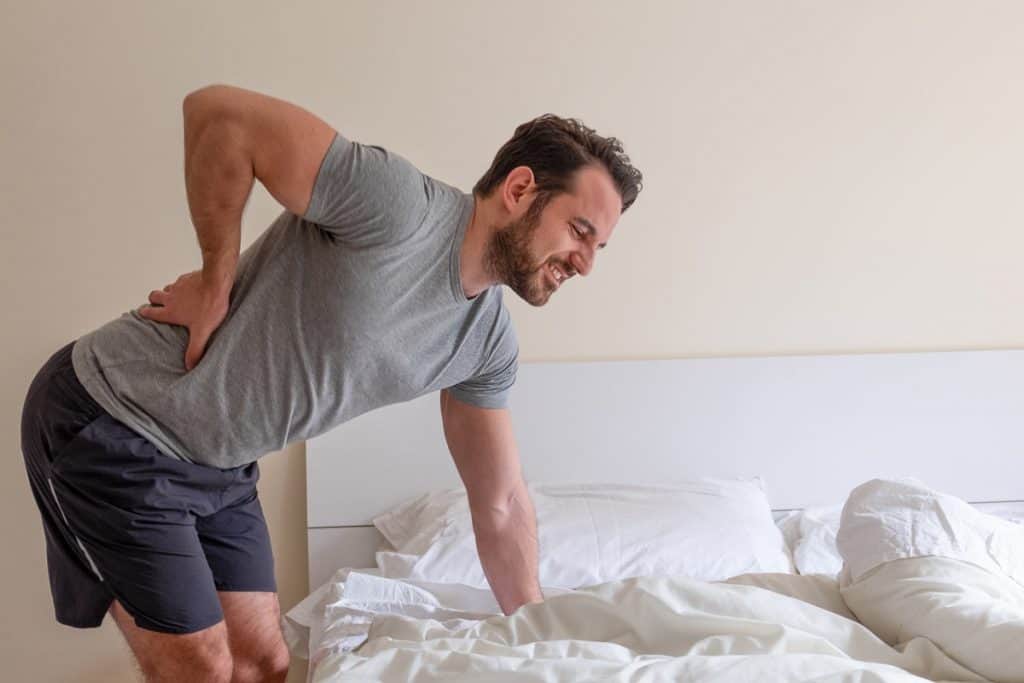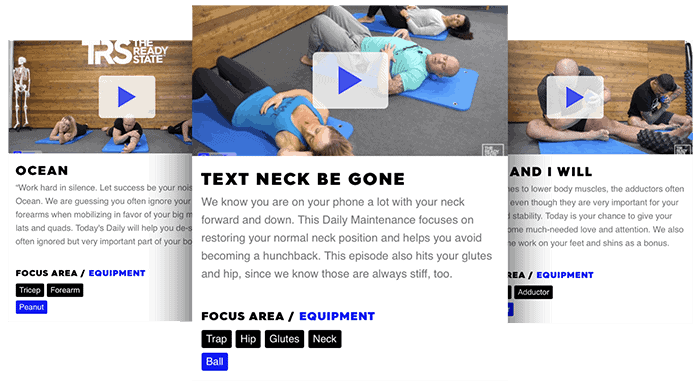How To Improve Sciatica Pain: Effective Techniques and Tips for a Pain-Free Life
Oh, sciatica!
If you don’t know her, you don’t want to. And if you do, you wish you didn’t.
Sciatica pain comes from an impingement of the sciatic nerve. It results in not just any old back pain but all sorts of annoying and inconvenient complications like:
- Incontinence (Loss of bladder and bowel control)
- Muscle weakness and inability to support weight
- Unintentional weight loss
- Night pain and night sweats
- Weakness or numbness in the lower back, buttocks, affected leg, and/or feet
She’s an unruly beast. Once she rears her ugly head, you’re doomed to a life of surgery or misery…
…Right?
But that narrative couldn’t be further from the truth. At The Ready State, we believe in challenging preconceived notions and recognizing the body’s inherent ability to adapt and heal.
Sciatica pain doesn’t have to dictate your future. With consistent physical therapy (and the right tools), you can find quick relief, reverse the pain, and prevent its recurrence.
Now let’s alleviate that lightning-like weakness in your legs for uninterrupted nights of peaceful sleep, shall we?
Sciatica Anatomy: What Is Sciatica Pain?
Before we get into techniques for relieving sciatica pain, let’s first clarify its nature, underlying causes, and risk factors.
Most people think sciatica pain emanates solely from lower back issues, such as a slipped herniated disk. Others may assume it’s an impingement between the lumbar spine and the buttocks. While these may or may not be the pain source, they’re not the be-all and end-all of root causes.
Sciatica pain differs from “normal” back pain. It emanates from irritation of the sciatic nerve, the largest nerve in the body. This long fibrous cord runs down your back, through your buttocks, down the back of the leg, down the calf and toes.
The tissues from the tips of your toes to your neck and trap muscles can influence this nerve. Hence, where the rats chew isn’t always where they came in. You may experience pain in your lower back or toes, but they’re not necessarily the root cause of your discomfort.
The piriformis muscle in the deep buttock region, for instance, is notorious for causing sciatic nerve irritation. When it tightens or spasms, it can compress the sciatic nerve and trigger sciatica symptoms.
This is a good thing. It means there are many opportunities to create relief when traditional methods prove ineffective.
Plus, I’ve got tools for both quick turnarounds from pain and long-term remediation of the base issue.
3 Exercises To Relieve Sciatica Pain
Now for the part you wanted to read. What the heck do I do?
If you’ve ever looked at any of our pain protocols, you’re probably already familiar with our common pain-relief system:
- Desensitize
- Restore
- Prevent
Desensitization techniques provide immediate relief for sciatica pain by facilitating a shift in the sensory input to your tissues. These involve addressing stiff tissues along the chain that may be compressing the sciatic nerve. They’re handy for targeting and reducing tissue sensitivity where sciatica pain occurs.
Sciatica doesn’t just happen in a vacuum; something along the chain no longer moves as it should. Enter restoration—where we get things back to competent positions that don’t cause pain.
These techniques address contributors like hip position and movement patterns which may have contributed to sciatica pain coming about. The goal is to bring your system back to a place of health and equilibrium.
Finally, we employ prevention techniques to ensure your sciatica pain doesn’t recur. These primarily focus on being mindful of your movement patterns and avoiding common positions that can trigger or exacerbate pain.
These stretches for sciatic nerve pain can be your ticket to finding relief and reclaiming your comfort. In the following section, we’ll delve into each technique in detail to help you perform them safely and effectively.
1. Desensitize: Relieve Sciatica Pain In The Short Term
Un-Panini The Glutes
The glutes and hip joint are the most problematic areas for sciatica pain. For this reason, the logical first step for desensitizing sciatica pain is to get after those posterior tissues.
Translation: it’s time for some butt stuff.
If you’ve ever heard me use the term “Panini butt” this is what I’m referring to: the gluteal tissues get pressed down and stiff like an overcooked panini, forgotten by a trucker, and accidentally sat on. This phenomenon can contribute to increased pressure on the sciatic nerve, leading to sciatica pain.
Consider these two sciatica stretches as a way of reducing pain in your glute tissues.
Work Upstream & Downstream
Contrary to some popular belief, the quadratus lumborum, or QL, isn’t a bone.
It’s a spinal stabilization tissue located alongside your spine, between the bottom of your ribs and the top of your hips in the lower back region.
Remember your body’s interconnected structures in the glute mobilizations? Only the pelvic bone separates your QL from those tissues.
All body tissues are literally tied together. Read Anatomy Trains for a mindblowing education on just how tied together by fascia we really are. This understanding opens up a powerful yet often oft-neglected approach to pain relief i.e., addressing the tissues upstream and downstream of the problem area.
Below the glutes, another significant area that can trigger sciatic nerve issues is your hamstrings. Regular exercises like forward folds, piriformis stretches, or seated hamstring stretches with legs extended can help alleviate this compression.
Bonus: Fillet Your Feet
The end of the sciatica, along with so many other nerve endings, is in the feet. A good old-fashioned foot scrub might be the lucky ticket for some fast sciatica relief, especially after addressing the above tissues. Plus, it just feels good.
1. Restore (Get the nerve tunnel back open)
Now that we’ve softened up the tissues around the sciatic nerve, we want to restore the nerve’s pathway to a healthy, unimpeded state.
In this case, the name of the game is hip capsule mobilizations.
People stretch their hamstrings and smash their quads way more often than they address the hip joint capsule. I think this is one of the reasons sciatica pain has such a reputation for stubbornness and difficulty healing.
Repositioning the joint back into proper alignment is a highly effective method for relieving pressure from the sciatic nerve.
The next mobilization won’t require any equipment. I recommend trying it once. Then doing it every day first thing in the morning if you find relief. Hold for 30 seconds and more to maximize effectiveness.
Have you got a stretch band? The banded hip distraction in this video is even better. Pro-tip: Don’t let the band pull your knees.
2. Prevent: Figure out what went wrong in the first place and correct it).
All sorts of things can go wrong when it comes to sciatica pain post-relief. I don’t expect you to know exactly what did it or where even after you’ve found relief.
However, I do want you to build good movement habits to improve sciatica pain in the long run.
Sedentism is often the biggest culprit for recurring pain. The longer you spend sitting on your buttocks without moving around, the more likely you’re going to end up driving a metaphorical tack into your nerve.
Create a movement-rich environment. The two hanging fruits for this are:
1. Sit on the floor: Sitting on the floor forces you to switch positions and postures often, preventing panini butt and has a secondary effect of flossing that big-ole posterior the sciatic nerve calls home. I’ve linked my full article on upgrading your ground game in the hyperlink.
2. Walk more: Not walking enough is one of the most common causes of musculoskeletal pain and restriction. How you feel when you’re walking is also a great way to see if your sciatica is still at bay or making a creeping, crawling, covert return.
Bonus: Incorporate heat or cold therapy into your prevention routine. Using a heating pad or applying ice packs to the affected area can help alleviate inflammation, reduce pain, and promote healing. Consult with licensed physical therapists for guidance on how to use these modalities to supplement your preventive efforts.
How To Improve Sciatica Pain In A Nutshell
Sciatica pain is a pain in the buttocks (all too literally), but it doesn’t have to be.
The tissues along the posterior chain influence the sciatica region. This gives you tons of opportunities for relieving pain and getting relief using desensitization. This starts with un-panini-ing your buttocks.
Once we have those stacked-like-pancakes tissues pulled apart, we can start the hip capsule’s restoration to optimal positioning. You can do this with our hip capsule mobilization or the banded hip floss mobilization with a handy stretch band.
Finally, when we get relief, preventing sciatica pain from ever stepping foot in the house again means optimizing our sitting environment and moving our butt a whole lot more. From learning to optimize your posture for the office desk to moving to the floor and then adding as many steps into your day as possible, there are plenty of opportunities.
Got questions, need more support, or just want to share your stories of success? Comment below or reach out to us about how these sciatica stretches to relieve pain are working for you.
Get rid of your sciatica pain for good. Get your ready state back today with a free trial.




















“Bonus: Incorporate heat or cold therapy into your prevention routine. Using a heating pad or applying ice packs to the affected area can help alleviate inflammation, reduce pain, and promote healing.”
I thought ice limits and slows down the healing process. So what’s with the recommendation here to apply ice packs?